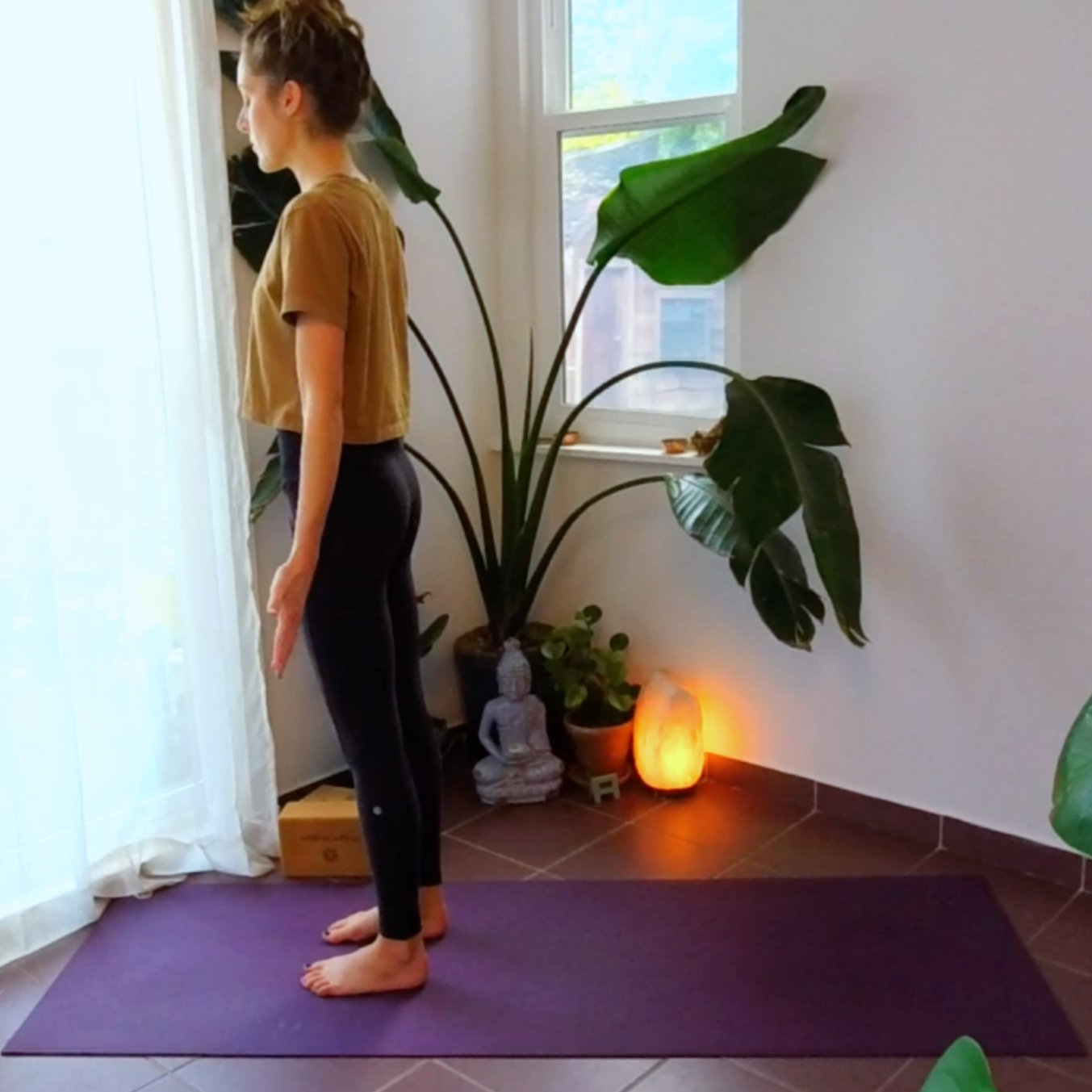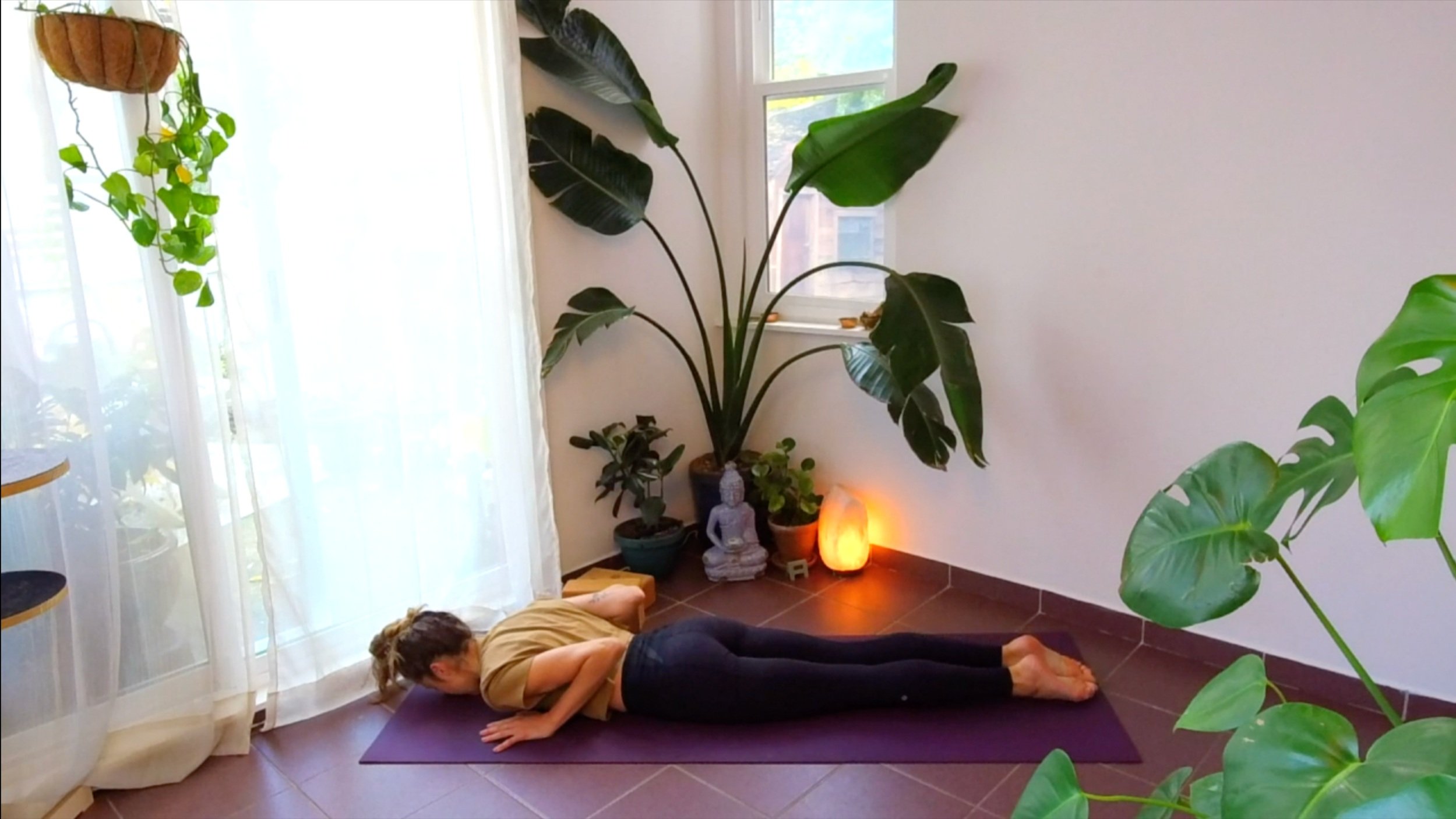Sun Salutation Tutorial: Surya Namaskara A
Sun Salutations History
Traditionally, Sun Salutations are exactly that: a salute to the sun. This dates back to Vedic times and traditions as a way of honouring the sun that gives life to all that is on this planet. In Sanskrit, Sun Salutations is surya namaskara; “surya” translating to sun, and “namaskar” which means to bow, or to honour. This series of postures brings the whole body to the earth and allows us to rise again, and again. We open and close, again and again. This sequence brings us through the contrast of light and dark, of the sun and the moon. It is a prostration, an act of honouring.
It is understood in Vedic knowledge that the heart is the seat of our wisdom, and it is our heart that is the sun within us. Our mind (brain) on the other hand is the moon, and therefore does not generate its own light (knowledge) and everything in it is just a reflection. Sun Salutations are a humbling of the moon (our mind) to the sun (our true knowledge and wisdom). Through the sequence of a Sun Salutation we bow our head below our heart a number of times.
Modern Day Yoga Classes
In modern day yoga practice, Sun Salutations serve as a warm-up. They build heat, allow practitioners to connect with their breath, strengthen and stretch both the front and back of the body, and bring movement into all joints, particularly the spine, shoulders, and hips. It is important to note that jumping straight into Sun Salutations may stress the body if it is not warmed up properly: the sequence includes many backbends that are not typically encountered in daily life and also may place significant weight on the wrists, necessitating some preliminary warming up. Many practitioners begin with a very gentle and mindful version of Sun Salutations that is highly modified, ensuring their bodies are not overly challenged right away. This approach provides the opportunity to truly feel the body and take an inventory of its needs.
Sun Salutation A
There are three main variations of sun salutations: Surya Namaskara A, Surya Namaskara B, and Hatha Surya Namaskara. Different lineages of yoga practice Sun Salutations in different ways, and at different times in a class sequence. For example, in the Ashtanga yoga lineage begins the practice with five Sun Salutations A and 5 Sun Salutations B.
This tutorial covers Surya Namaskara A.
MIX & MATCH: Components of Sun Salutation A
A Sun Salutation encompasses numerous elements and postures (asanas), and there is no single correct way to do them. This changes person-to-person, as well as day-to-day for the individual. When discussing modifications in a yoga context, it’s important to note that they are not inferior in any way. The term “modification” simply refers to a change made. These modifications allow you to tailor the practice to fit your needs at any moment, day, or stage of your life.
Essentially, there are certain components that make up the sequence of a Sun Salutation: reaching tall, a forward fold, a half-lift, a plank, a backbend, a downward facing dog - and a transition between each. You can think of each component as a category containing a number of different asanas that you could use to satisfy that component “requirement.” Basically, it’s just mix and matching!
-
Mountain Pose
Upward Salute
-
Forward Fold
Halfway Lift
-
High plank
Kneeling plank
-
Baby cobra
Cobra
Upward facing dog
-
Downward Facing Dog
Child’s pose
Any other resting posture
-
Respectively through the sequence:
Journey into plank
Lowering down into backbend
Transitioning into downward facing dog
Journeying into halfway lift
Let’s take a look at the different components and options in depth:
REACHING TALL
At either end of a Sun Salutation there is this category of “reaching tall.” This consists of two central postures: Tadasana and Urdhva Hastasana.
At the beginning of the Sun Salutation you start in tadasana (mountain pose), and move into urdhva hastasana (upward salute). To finish the round off you move from urdhva hastasana to tadasana.
Let’s break these down a little bit more.
1) Tadasana / Mountain Pose
This is the very starting point of a Sun Salutation.
Standing with feet together, or slightly apart, and pressing both feet into the ground and away from centre. You should feel this activate up the legs all the way up to the pelvis. Press tailbone AND pubic bone towards the earth. Feel the udiyana bhanda (energy lock) activate in the lower belly - this should feel like a slight abdominal engagement between the naval and pubic bone. Shoulder blades are drawing together, tops of the shoulders away from ears. Palms facing forward and fingers spread wide (or hands at heart center). Chin parallel to the ground so you can feel a lengthening of your neck. Press the crown of the head up towards the ceiling.
2) Urdhva Hastasana / Upward Salute
This is simply pressing into the feet and reaching up.
Option to take a little bit of a backbend. Make sure that you’re not collapsing into the lower back but rather that you are using the strength from the front of your body and your glutes to support you here.
Feel a lengthening of the front of the body as well as the sides of the body. This length comes from the two feet connected on the ground.
FOLDING & LIFTING
These two postural components happen twice in a Sun Salutation, just in different orders: Uttinasana and Arhda Uttanasana. At the beginning of the Sun Salutation we fold forward and round, then half-way lift. At the end of the Sun Salutation it’s the halfway lift first, and then folding into uttanasana.
1) Uttanasana / Forward Fold
This posture is a simple forward fold. Feet can be together or apart. Knees can be bent or legs can be quite straight. Avoid locking out the knees and instead keep a subtle bend into them to encourage fluidity and ease in the body. Let the arms and head hang heavy.
At the beginning of the Sun Salution you fold into this posture; at the end of the Sun Salutation you rise back up into Urdhva Hastasana from Uttanasana.
2) Arhda Uttanasana / Halfway Lift
This is posture where we lengthen the spine back up. Begin by shifting the weight into the heels and slightly bend the knees. Lift the torso parallel to the earth while the shoulder blades are sliding towards the spine, and the tops of the shoulders are moving away from the ears. Hands placed either on blocks, the ground or on your shins. The goal here is to really find this lengthening (not rounding) of the spine. Be careful not to arch into a backbend, but keep the low ribs drawn in and invite length into both the front and back of the body.
At the beginning of the Sun Salution you use this as a foundation to step back from; at the end of the Sun Salutation you step from Downward Facing Dog into this half-way lift.
VINYASA
A vinyasa consists of three components: plank, backbend and downward facing dog. Let’s explore each of these in depth.
1) Plank / Phalakasana
After moving from tadasana and the first halfway lift, you transition into the plank and either keep the knees lifted up, or lower them down to the ground.
1.a) Plank Variation
In plank, align the shoulders over the wrists and the balls of the feet under the heels. Your body is a “board” of strength here, with a stability across both the front and back of your body, from the crown of the head down to the heels. Shoulder blades are protracted (spread apart slightly with strength) as you press the hands into the earth and take the top of the shoulders away from the ears as you slide the shoulder blades down the back of the body.
1.b) Kneeling Plank Variation
In this variation of plank, the knees are down onto the ground but all of the engagement and stability still exists. This time, that engagement (or “board-like” quality) is from the crown of the head to the knees.
2) Backbend
In this category, essentially there are three different backbends that you can "plug” into the sequence depending on your needs, energy levels, etc. This consists of thee central postures: baby cobra, cobra and upward facing dog.
First, you’ll lower down from plank slowly and intentionally. You can either keep the knees lifted, or lower them down to the ground before you do so.
Once you make it all the way down, flip the feet over so that the shoelace side of the feet are down on the ground - keep the toes touching the earth the whole time. In each of these postures be sure to keep the shoulder blades drawn together and sliding down the back. Find a very slight tuck of the chin in towards the chest to lengthen the back of your cervical spine (neck).
All three postures can be transitioned into from the prone position of laying on your belly. If you’re transitioning into upward facing dog you have the additional choice of moving into chaturunge dandasana before sliding into upward facing dog (more on this in the transitions section).
2.a) Ardha Bhujangasana / Baby Cobra
This is a little backbend where the low ribs are still connected to the ground. If you are on your belly and lift your head and chest, as well as your hands, the place that your body naturally falls to here is a good indication of how high you should be lifting in your baby cobra. This is a mellow backbend.
2b. ) Bhujangasana / Cobra
This cobra is a deeper backbend. You might find it helpful to adjust the placement of your hands slightly forward. Your hip bones and pubic bone stay connected to the ground. This can be a deceivingly difficult posture, so listen to your lower back! It might not be so happy with this variariation.
2c.) Urdva Mukha Svanasana / Upward Facing Dog
In this backbend, your hands and tops of feet are on the ground with the knees lifted. Both the front and back of your body are held strong. Hands line up under the shoulders.
3. Adho Mukha Svanasana /Downward Facing Dog
From your backbend you’ll either slide right into downward facing dog from upward facing dog, or you’ll lower to the belly first and then come up to downward facing dog. Some practices, or for some vinyasa’s in a practice, you might come into a table top or a child’s pose instead.
There is a full tutorial, just like this one, solely on downward facing dog on the Healing Hub Subscription.
Gain instant access to the Healing Hub which includes over 400 Yoga and meditation classes.
Transitions
Halfway-lift into Plank
This transition utilizes the “flat back” and the engagement along the spine established in the arhda uttanasana to set up a strong foundation for plank. As you transition try to keep your spine in that lengthened state, shoulder blades together, and control in the lower belly as you place your hands down to the earth or on blocks (bend into your knees and lift you heels as much as you need to) in order to step back into plank, and then change into any modification you need.
Plank into Backbend
1) Plank variation > belly > backbend
From plank or kneeling plank, lower all the way down onto the belly. Flip feet over and press into hands to either lift into: baby cobra, cobra, or upward facing dog.
2) Plank > chaturunga > upward facing dog
Another way to get into upward facing dog is to move from plank into chaturunga dandasana and then into upward facing dog. For this transition, when lowering into chaturunga you only lower half way (lowering only until the elbows are at a 90 degree angle, or the upper arm bones are in line with the torso). From this lowered and stable place, press into the hands to lift head and heart up into the backbend. Flip feet over, either one at a time or simultaneously.
Chaturunga Dandasana
Backbend into Downward Facing Dog
1) Baby Cobra or Cobra > Downward Facing Dog
If in baby cobra or cobra, lower chest and forehead back down to the earth. Place hands firmly down underneath the shoulder blades, tuck the toes, and press up either into:
a) plank - by tucking the toes under, lifting the knees, and powerfully pressing up.
b) kneeling plank - keep knees on the ground as you press up, but keep the engagement in belly.
c) tabletop - keep both hands and knees on the ground.
Once in either a, b, or c, move into downward facing dog.
2) Upward Facing Dog > Downward Facing Dog
From upward facing dog, the hands stay the same in the same position. Find the transition coming from engagement in the lower belly as you hinge at the hips and draw them up and back (as if you were gently being lifted up from this hip crease). As you lift back flip your feet over, either one at a time, or both simultaneously.
Downward Dog into Halfway-lift
There are three main ways to come from downward facing dog into the halfway lift at the top of the mat. These can be seen in more depth in the video. From downward facing dog:
a) walk - Take a bunch of little steps until your feet are at the top of the mat, then lift spine up into a halfway lift.
b) step - Draw a knee in towards the chest nice and tight, slide forward into a plank position to place the foot between the hands. Step the other foot beside it as you simultaneously lift the torso into the halfway lift.
c) tabletop - Lift the the heels nice and high, bend deeply into the knees. Find a sense of buoyancy and bounce in the lower body. Look between the thumbs, crouch low and jump forward between the hands and land with the torso lengthened into the halfway lift.
sun salutation vs vinyasa
Often there is confusion about the difference between a Sun Salutation and a Vinyasa. The Sun Salutation starts and ends with tadasana, and moves through the entire sequence of postures. A Vinyasa is the transition of: plank -> lowering down -> backbend -> downward facing dog
How & When to Modify
Remember, this is a mix and match experience! Maybe you start your practice with lots of modifications making it nice and gentle (knee plank and baby cobra?) and then work up to something that is a bit more challenging (plank and upward facing dog?). Or, maybe you do the opposite - start strong and modify as you get fatigued. Maybe each one is entirely different and truly based on what you feel in the very present moment of each part of the sun salutation.
Be sure to watch the video portion of this tutorial for an example of an entirely modified sun salutation.
It’s your body, it’s your practice - make it what you need it to be!
Video tutorial
Here is a video tutorial to summarize everything discussed in this article. The visual practice can be helpful in tying everything together!














